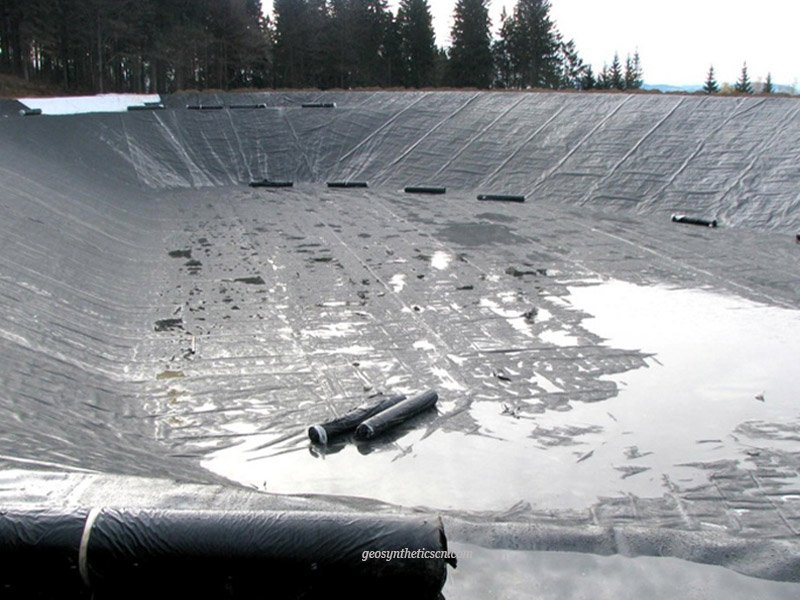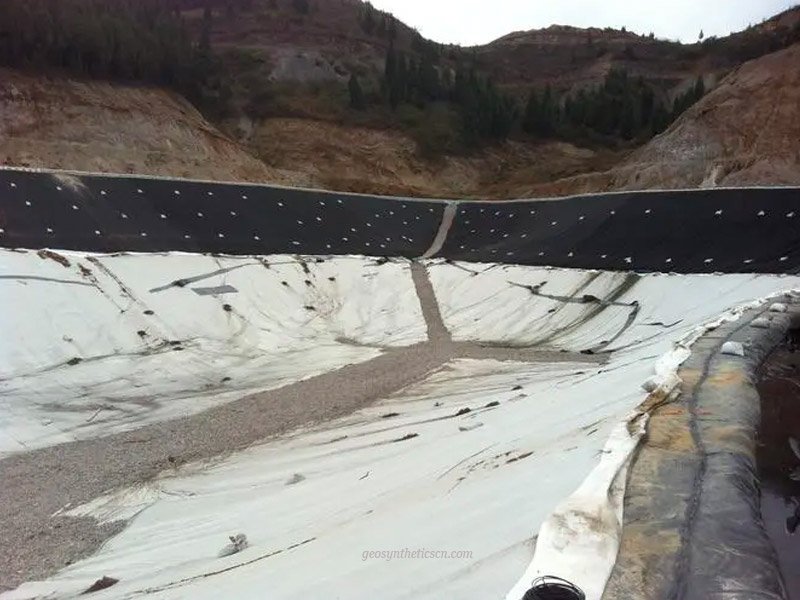Geomembrane vs geotextile, what is the difference when used in civil engineering and environmental applications? On the other hand, geomembrane and geotextile are both geosynthetic materials used in civil engineering and environmental applications, what are the similarities between the two?
GEOSINCERE is the professional geosynthetics manufacturer and supplier, we offer complete line of geomembrane and geotextile. In this article, let’s explore the material composition, functional characteristics, and main applications of these two crucial geosynthetic materials. We hope it will helpful for you to choose the right geosynthetic material in various civil engineering, construction, and environmental projects.
1 Introduction
The geomembrane is impermeable to water, whereas geotextile fabric is water permeable. The geomembrane is often made of high density polyethylene material, while the geotextile is made from polypropylene or polyester fibers processed by woven, needle punched or heat bonded methods. That arises problems in many companies and individuals when it comes to purchasing geotextile and geomembrane. What is the difference of geomembrane vs geotextile? How to choose bwteen geomembrane and geotextile?
1.1 What Is A Geomembrane
A geomembrane, an exceptional waterproof and isolation material with unique attributes, is predominantly utilized in hydraulic engineering for a multitude of functions. It is primarily composed of high density polyethylene, with a thickness ranging from 0.3 mm to 30 mm. Geomembrane’s exceptional compressive strength enables it to withstand heavy loads without any deformation, a quality that is crucial in hydraulic engineering. Additionally, the material is highly resistant to high temperatures, ensuring its adaptability in diverse climates and weather conditions.
It is crucial to emphasize that the quality of smooth geomembrane HDPE Liner can vary depending on the manufacturing process and the quality of raw materials used during production. For hydraulic engineering applications, it is crucial that the geomembrane meets specific performance criteria, including a minimum density of 90 kg/m3, an extreme elongation rate of 300%, an anti-freeze property of -60°C, and a stabilization efficiency of not less than 2% of carbon black in polyethylene. The stability and resistance to environmental changes largely depend on these factors.
GEOSINCERE geomembrane is a premium geosynthetic membrane crafted from high-grade polyethylene raw material. Formulated with additives such as carbon black, antioxidant, anti-aging agents, and UV-resistance components, it undergoes state-of-the-art automatic production processes and advanced pressing technology. GEOSINCERE main geomembrane products includes smooth geomembrane, textured geomembrane and composite geomembrane liner, and more.


1.2 What is A Geotextile
A Geotextile is a flexible geosynthetic material crafted from polypropylene, polyester, or nylon. It finds applications in engineering, serving roles like slope reinforcement and soil filtration. With customization options for thickness, strength, and drainage capabilities, this versatile material caters to specific project requirements. Widely used in civil engineering, it extends its utility to road construction, drainage systems, and environmental remediation projects. When employed for slope reinforcement, geotextile fulfills various functions, including preventing soil erosion, establishing drainage channels, and acting as a supportive layer for other construction materials.
GEOSINCERE brand includes a range of geotextiles, such as short staple needle punched geotextile fabric, filament polyester geotextile, polypropylene woven geotextile, and PET woven geotextile. Beyond manufacturing top-quality geotextile products, GEOSINCERE excels in offering professional design and installation services. The brand also caters to customized needs with options for OEM, ODM, and bespoke development and fabrication.
2 What is the Similarity of Geomembrane and Geotextile
2.1 Both Are Classified as Members of Geosynthetic Materials
Geomembrane and geotextile belong to the broader category of geosynthetic materials, playing crucial roles in various civil and environmental engineering projects. Renowned for their versatile applications, these materials have become indispensable components in the fields of infrastructure and environmental management.
Geomembrane and geotextile both embody the collaborative effort of engineering and materials science, providing sustainable solutions to the inherent complex challenges in modern construction and environmental protection. With the continuous development of these geosynthetic materials, their importance in ensuring the resilience and sustainability of civil engineering projects remains crucial.
2.2 Both Geomembrane and geotextile Are Used for Environmental Protection
Geomembranes and geotextiles, as integral components of environmental protection initiatives, serve multiple purposes by providing substantial contributions to impermeability, containment, and soil stability. These versatile geosynthetic materials, carefully engineered to meet the stringent requirements of diverse projects, play crucial roles in safeguarding the environment and ensuring the longevity of infrastructure.
2.3 Both Are Corrosion Resistance and Durability
The remarkable combination of corrosion resistance and durability displayed by both geomembrane and geotextile highlights their versatility and dependability in demanding environmental conditions. The inherent strength of geomembranes and geotextiles enables these geosynthetic materials to remain essential elements in projects prioritizing long-term performance and environmental sustainability. Geotextile and geomembrane provide reliable solutions, ensuring lasting protection and functionality in a wide range of applications. Whether it’s safeguarding against water seepage or reinforcing soil structures, these materials consistently deliver the necessary performance and reliability, making them indispensable in various industries such as civil engineering, construction, and environmental remediation. Their ability to withstand and mitigate environmental challenges solidifies their position as critical components for sustainable and resilient infrastructure development.


3 What is The Difference of Geomembrane vs Geotextile
3.1 Material and Manufacturing Process
Geomembranes liners are commonly manufactured using the extrusion method, utilizing high-density polyethylene (HDPE) material. This geomembrane manufacturing process results in a durable and impermeable membrane that is capable of withstanding environmental stresses. On the other hand, geotextiles are typically produced from polypropylene or polyester fibers. These fibers undergo weaving, needle punching, or heat bonding techniques to create a geo fabric with desired properties. The selection of materials and manufacturing techniques for geomembranes and geotextiles ensures their suitability for specific project requirements, providing effective solutions for environmental protection, soil stabilization, and water management.
3.2 Water Permeability
The geomembrane is impermeable to water, whereas geotextile fabric is water permeable. Geomembranes have excellent waterproof property and are widely used to prevent seepage, while geotextiles have good drainage and filtration properties. When we usually use them together. The They are classified into one fabric and one membrane, and two fabrics and one membrane, which have stronger reinforcement and anti-seepage performance.
Geotextiles serve as an effective filter, separating and reinforcing different materials while providing essential support and stability. Geotextiles are designed with a high permeable coefficient, which is typically 10 times greater than the soil’s permeability coefficient. This ensures efficient drainage and prevents the fine particles from being carried into the geotextile. As the geotextile filters the soil, it creates an artificial drainage layer, which traps the coarse particles and forms a protective layer. This layer is characterized by a high saturation coefficient, but its ability to retain fine particles is limited.
3.3 Different Functions in Practical Application
The primary function of geomembrane is to insulate groundwater and other pollutants, such as sewage and silt, in engineering projects, while preventing the penetration of soil particles, sand, and other materials. This ensures the stability and safety of the project. Geotextile, on the other hand, is mainly used for reinforcement and isolation in engineering applications, such as the construction of roads, levees, and other infrastructure. It is also employed for the decoration and protection of parks, golf courses, roofs, and other surfaces.
Both geomembranes and geotextiles have applications in various industries, including civil engineering, environmental protection, agriculture, mining, and more. The specific application depends on the project requirements and desired functions of the materials.
3 Conclusion
In conclusion, while geomembranes and geotextiles may sound similar as the important gepsynthetic material, their distinct compositions and functions make them indispensable in different applications within the realm of geosynthetics. By understanding their unique attributes, engineers and environmental professionals can harness the full potential of these materials, ensuring the success and longevity of their projects.
GEOSINCERE is the expert in geosynthetics, we encourage you to explore the tailored use of geomembranes and geotextiles in your projects. For further insights or assistance, feel free to reach out, we can navigate the intricate landscape of geosynthetic solutions. We trust that this blog post has provided valuable insights into the distinctions of geomembrane vs geotextile. It will be helpful to you.
Thank you for reading.





